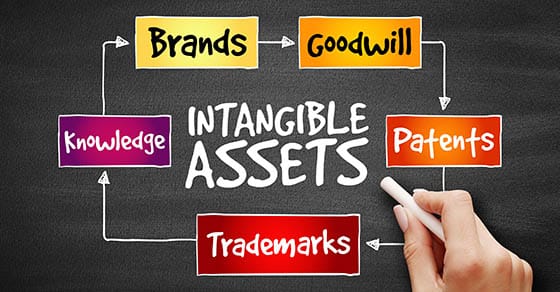Intangible assets — such as patents, copyrights, trademarks and customer lists — can have substantial value. But, unless they’re purchased from a third-party, you might not know what they’re currently worth. For example, if a business cultivates a well-known brand over several years using internal resources, it won’t appear on its balance sheet.
Owners of intangibles need to know the value of these assets in various situations. For example, the value of intangible assets may be relevant when buying or selling a business, reporting acquired intangibles under U.S. Generally Accepted Accounting Principles (GAAP), licensing rights to or joint venturing with a third party, and litigating asset infringement or breach claims. The value of intangibles also can be important in matters such as divorce settlements and estate planning.
However, intangible assets present unique challenges that necessitate the use of an experienced business valuation professional. Valuation experts typically consider three approaches when valuing intangibles.
1. Market approach
Value may be based on transactions involving assets that are similar to the subject property. Comparable, arm’s-length transactions are selected using a variety of factors, including:
- The legal rights conveyed,
- Financing arrangements,
- The industry where the asset will be used,
- Physical, functional, economic and technological properties of the asset, and
- Whether any nonintellectual property assets were included in the transaction.
Once comparable transactions are selected, multipliers are devised to compare those transactions to the subject asset, and prices are adjusted accordingly.
2. Cost approach
Value is sometimes determined by quantifying the costs the intended buyer would incur to develop or acquire the intellectual property asset. Valuators consider several factors, such as:
- The cost to produce a comparable asset,
- Supply and demand for the asset, and
- Functional, technological and economic obsolescence.
Perhaps the most critical factor under the cost approach is which cost to determine — the cost to reproduce the asset or the cost to replace it? Reproduction would involve assembling an exact replica of the asset, employing the same standards, materials and design originally used. Replacement involves developing a new asset with the same utility as the subject asset but possibly in a different form.
The replacement asset may be superior to the subject asset in some way, requiring an adjustment to the valuation. Further adjustment might become necessary if the replacement process took advantage of current approaches, quality and prices that were unavailable when the original asset was conceived.
3. Income approach
Value is often derived from the asset’s future economic benefits. Examples include:
- Income gained by owning the intellectual property, as opposed to not owning it (including royalties generated by licensing the asset to third parties),
- Reduced costs associated with owning the intellectual property (that is, the owner saves because it doesn’t need to acquire the asset or develop a reproduction or replacement), and
- Royalties saved (that is, the amount of royalties the owner would be willing to pay to generate the profits the intellectual property is now earning).
There are two common techniques that fall under this approach. First, under the direct capitalization method, the income associated with the property for a single future period is calculated, then that figure is divided by an appropriate rate of return or capitalization rate.
Alternatively, under the discounted future economic benefits method, the valuator projects income for several periods into the future and converts that income to present value using a discount rate. The discount rate represents the investor’s required rate of return over the projection period. Both the direct capitalization and the discounted future economic benefits rates are adjusted for a variety of factors.
Get it right
When it comes to valuing intangibles, the market and cost approaches are generally more difficult to apply than the income approach. Why? It can be challenging to find truly comparable sales (or royalty rates) for similar types of assets or accurately estimate the cost to replicate a unique intangible. When handling these hard-to-value assets, it’s critical to hire a qualified business valuator with expertise in valuing intangibles to help determine what’s right for your situation.
© 2023




